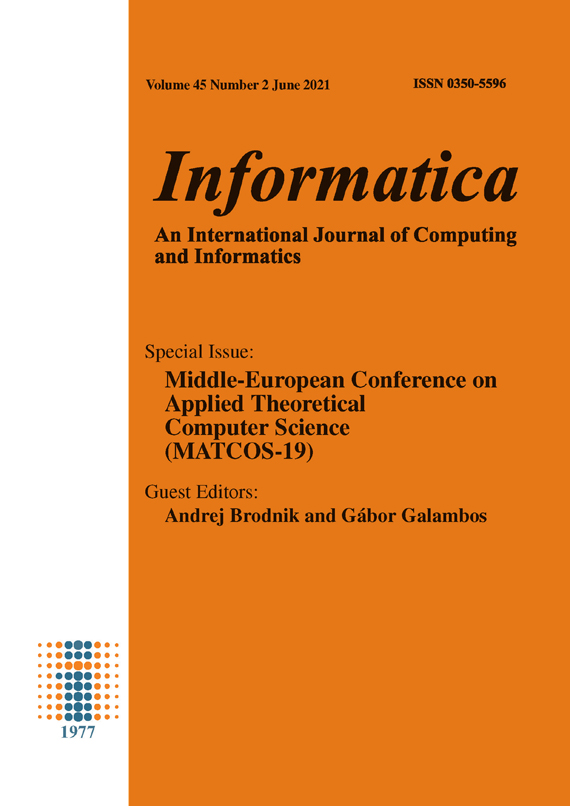Routing Algorithm in Networks on the Globe
DOI:
https://doi.org/10.31449/inf.v45i2.3200Abstract
Packet switching of data in networks is done by either the distance-vector or the link-state routing protocols. These protocols use the Bellman-Ford and the Dijkstra's algorithms re-spectively for the least cost path from a source base station to a destination station. For inter-network transmission, the path-vector routing protocol is in use. With progress of
time, the network topologies are becoming huge in size, requiring large demand on book keeping of routing tables and transmission of the data packets dynamically to several other
stations of the network by broadcast, increasing the load on the network. Here, assuming the router stations to be terrestrially located with links along the ground, a large network
is assumed to lie on a spherical surface, and so the shortest geodesic path from source to destination becomes a great circular arc. For fast transmission, the cost of a link to a node
is multicast to its neighboring nodes only for selection of the path lying as close as possible to the geodesic line between the source and the destination. As the arrival and dispatch
of data packets at a nodal station occurs randomly, the cost of a link is estimated in this paper by the waiting time of a queueing process. This process at a router station is thus modeled by the Markovian M=M=c model, where c is the number of servers at the router station. If other commercial xed charge is involved for the use of a link, then that can be included in the total cost of a link. Finally, a method of search of a mobile destination
is also presented using sphericity of the network. Algorithms for the near geodesic path, costs of links as waiting times and destination search in mobile environment are clearly
presented.
References
M. Abramowitz and I.A. Stegun, Hand-
book of Mathematical Functions,Dover
Publications, New York, (1972)
M. Arellano-Vazquez, M. Benitez-Perez,
J. Ortega-Arjono, A consensus routing algo-
rithm for mobile distributed systems, Int. J.
of Distributed Sensor Networks, 11, (2015)
R.E. Bellman, On a routing problem,
Quart. Appl. Math. 16, (1958), 87-90
S.K. Bose, Operations Research Meth-
ods, Narosa Publishing, New Delhi, (2012)
C. Busch, Tirthapura: Analysis of Rout-
ing Algorithms, SIAM J. Comput. 35, 305-
, (2005)
Cisco Systems: IOS IP Routing, RIP
Conguration Guide (2011)
Cisco Systems: An Introduction to
IGRP, (2005)
Cisco Systems: IOS IP Routing, OSPF
Command Reference (2011)
T.H. Cormen, C.E. Leiserson, R.L.
Rivest, C. Stein, Introduction to Algo-
rithms, McGraw-Hill (2009), 651-655
A. Dutta, H. Schulzrine, Mobility Pro-
tocols and Handover Optimization, John
Wiley, New York, (2014)
L.R. Ford, Network Flow Theory,
RAND Corporation paper P-923, Santa
Monica, California (1956)
P. Li, S. Guo, S. yu, A.V. Vasilkos, Reli-
able Multicast with Pipelined Network Cod-
ing using Opportunistic Feeding and Rout-
ing, IEEE Transactions on Parallel and Dis-
tributed Systems, 25 (2014)
Downloads
Published
Issue
Section
License
I assign to Informatica, An International Journal of Computing and Informatics ("Journal") the copyright in the manuscript identified above and any additional material (figures, tables, illustrations, software or other information intended for publication) submitted as part of or as a supplement to the manuscript ("Paper") in all forms and media throughout the world, in all languages, for the full term of copyright, effective when and if the article is accepted for publication. This transfer includes the right to reproduce and/or to distribute the Paper to other journals or digital libraries in electronic and online forms and systems.
I understand that I retain the rights to use the pre-prints, off-prints, accepted manuscript and published journal Paper for personal use, scholarly purposes and internal institutional use.
In certain cases, I can ask for retaining the publishing rights of the Paper. The Journal can permit or deny the request for publishing rights, to which I fully agree.
I declare that the submitted Paper is original, has been written by the stated authors and has not been published elsewhere nor is currently being considered for publication by any other journal and will not be submitted for such review while under review by this Journal. The Paper contains no material that violates proprietary rights of any other person or entity. I have obtained written permission from copyright owners for any excerpts from copyrighted works that are included and have credited the sources in my article. I have informed the co-author(s) of the terms of this publishing agreement.
Copyright © Slovenian Society Informatika








